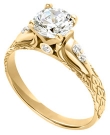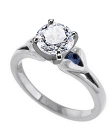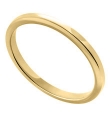14K Yellow Gold Engraved Engagement Ring with Round Diamonds (.09 ct. tw.)




I was just checking the status of the ring. I checked online and it says "pending." I don't know if you remember, but I ordered my fiance's engagement ring from you and spoke to you several times on the phone. I would just like to say that she loves the ring and I appreciate your outstanding customer service.
Thank you,
Jarrit
Diamond Clarity - Why it's Important
The term diamond clarity refers to the presence or absence of tiny birthmarks, or inclusions from minerals or fractures while the diamond was forming in the earth. These birthmarks may be present in the form of a blemish, scratch, air bubble or any other foreign material, either inside the diamond or on its surface. Anything disrupting the flow of light in the diamond, such as an inclusion, will reduce the amount of light or sparkle that is reflected. As you would expect, diamonds with no or few inclusions receive a higher rating for diamond clarity and are more valuable than those with noticeable birthmarks. Danforth Diamond uses the GIA system that standardizes clarity based on the number, location, size and type of inclusions.

F - IF Diamonds: Flawless or Internally Flawless - Diamonds in this category have no internal inclusions. They are extremely rare and highly valued. If you are looking for the best diamond you can buy, then look no further than the F-IF category. These stones are perfect.
VVS1 - VVS2: Very, Very Slightly Included - These two grades of VVS Diamonds have minute inclusions that are extremely difficulty to detect even with 10x magnification. You don't have to pick a stone with absolutely no inclusions to get a stunning diamond. These diamonds are excellent choices as well, since their inclusions are minor and invisible to the eye. These diamonds offer cost savings without sacrificing too much in terms of clarity.
VS1 - VS2: Very Slightly Included - These two grades of Very Slightly Included Diamonds have minute inclusions that are not visible to the naked eye and are difficult to see under magnification. Requires 10X magnification to clearly see an inclusion. VS clarity diamonds are a good choice for someone wishing to balance high quality with relative affordability.
SI1 - SI2: Slightly Included - These two grades of slightly included diamonds contain inclusions that are evident under 10x magnification and may be seen by the naked eye in some cases (generally in SI2 diamonds). If your goal is maximizing size and/or affordability, look at SI1 and SI2 diamonds. Many of these stones are what professionals call "eye-clean," meaning they have no visible inclusions. Danforth Diamond evaluates all SI diamonds to sort out and eliminate diamonds with visible inclusions.
I1 - I3: Inclusions visible to the unaided eye - Diamonds contain significant inclusions that are visible both under magnification and to the naked eye. Because "I" grades have inclusions that can be seen with the naked eye, we do not recommend that you buy these diamonds for an engagement ring. Therefore, we do not offer "I" quality diamonds in our loose diamond inventory. This is one more way that Danforth Diamond helps you select your perfect diamond.

Expert Guidance
Diamonds that have no inclusions under magnification are extremely rare and are rated F for flawless. Even with a 10x loupe, the diamond's birthmarks in the VVS (Very, Very Slightly Included) to VS (Very Slightly Included) range can be very difficult to find. It is only when a diamond is graded "I" that it is possible to see the birthmarks easily with the naked eye.
As with real birthmarks, inclusions appear as different shapes, such as crystals, clouds or feathers. These idiosyncrasies often add to the overall character of the diamond. The majority of these natural birthmarks are invisible to the naked eye, yet they affect the way light reflects and refracts within the stone. The position of inclusions can affect the value of a diamond.
What is the difference between VVS1 and VVS2 or SI1 and SI2? The numbers represent levels within each diamond clarity grade. The 1s will be cleaner (have fewer or smaller inclusions) than the 2s, which allows for more precise grading categories. One more thing you should know—inclusions do have an up side. When GIA, AGS and IGI certifies a diamond, it includes a "plot" of the stone's inclusions. Since no two diamonds are alike in their patterns of inclusion, this plot is used as a "fingerprint" to uniquely identify your diamond.
The table below compares the prices of round diamonds with the same carat weight, color and cut grades. (Prices subject to change, depending on Diamond Market fluctuations.)

Use the links below to learn more about diamonds and the 4 C's:
Now that you’ve learned all about diamonds; use your knowledge to shop for your perfect diamond engagement ring.
